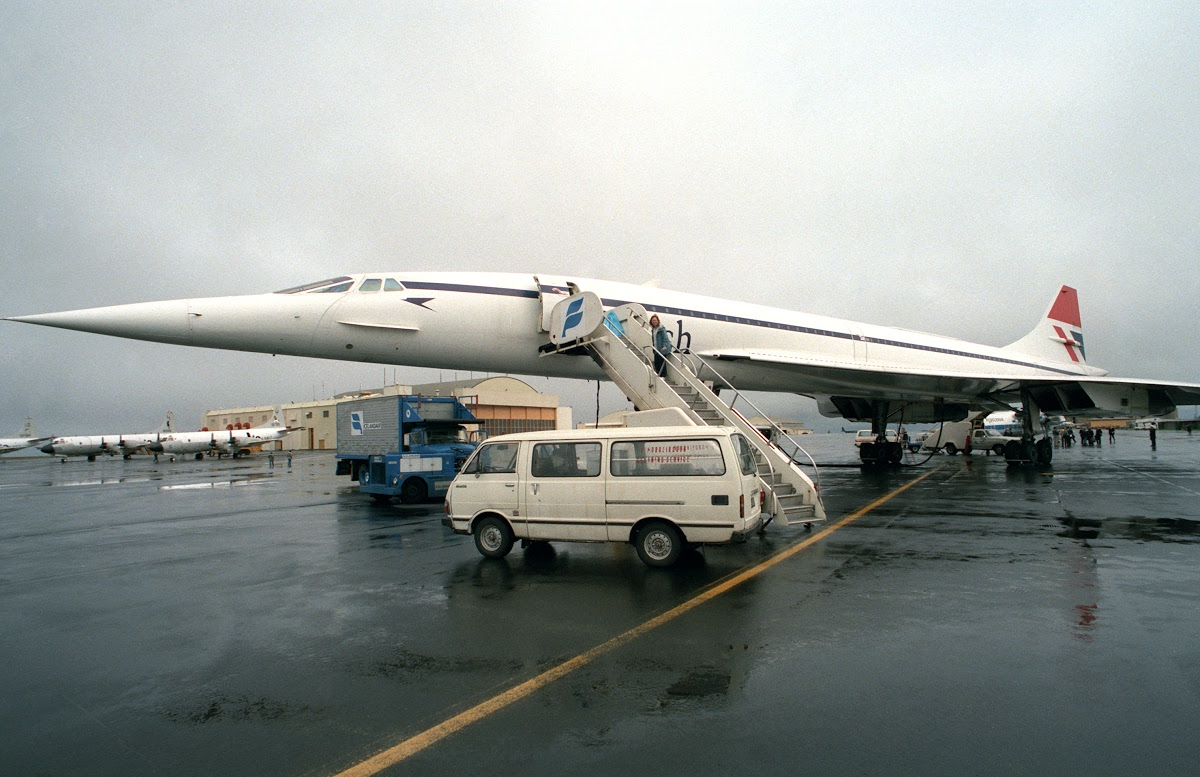Concorde

Concorde at Keflavik (BIKF) in 1977.
Concorde, the world’s only successful supersonic airliner, was retired two decades ago in real life. However, in the skies of VATSIM, she lives on in the hands of a small number of nostalgic pilots. Iceland, particularly Keflavik (BIKF), was an occasional charter destination for Concorde, and hence one may sometimes find virtual pilots flying virtual Concordes to/from Iceland on VATSIM.
For the most part, controlling Concorde is similar to controlling any other civilian airliner, with a few unique considerations for its supersonic mode of flight.
Portions of this guide have been adapted from the VATSIM UK Concorde Information Sheet. Many thanks go to the authors of that sheet for their work.
Flight Planning and Clearance Delivery
Below is an example of a Concorde flight plan routing from BIKF to EGLL:
RIMUM/M200F430 DCT C/61N020W/M200F450F600 DCT 5230N01500W LULOX/N0566F350 DCT TACQI DCT BAPHU DCT OCTIZ DCT SIRIC
Some waypoints are prefixed with “C/" and have two sets of flight levels listed for said waypoint. This means that Concorde will perform “cruise climb” at those waypoints within the block of flight levels listed – i.e., gently climbing and descending within the block, for fuel efficiency.
For example, "C/6120N/M200F450F600" means that starting from 6120N, the aircraft will cruise climb at Mach 2, within the block FL450-600.
Concorde's supersonic cruise speed is always Mach 2, and its supersonic cruising level is the block of FL450 to FL600. To enter this information into Euroscope, controllers should:
- Enter
M200into the Scratchpad to set the MACH item at 2.00.- It is not possible to manually enter a Mach higher than 1.00 in the Departure List using Euroscope/TopSky's menu, but using the Scratchpad will bypass the menus.
- Then, enter
BLOCK F450-600(or other appropriate text) into the Scratchpad, as a reminder of Concorde's cleared block level.
Aircraft Characteristics
Ground
On the ground, Concorde has a higher fuel burn than most aircraft. GND should therefore minimize any delays for Concorde on the ground (this does not necessarily mean priority handling.)
Departure
Controllers should ensure a minimum 10 min separation between Concordes on the same route.
Airborne
Generally, Concorde can abide by most standard instructions while subsonic, albeit at much higher speeds and climb/descent rates.
Climb
Generally, a departing Concorde will accelerate to 250 KTS immediately after departure, and will climb rapidly. As most Concorde traffic departing Iceland is on the BIKF-EGLL route, a route on which Concorde is usually lightly fueled, controllers may expect a rate of climb of 5000+ fpm.
Traffic permitting, controllers may approve a "no speed restriction" or "high speed" climb for Concorde, which will help its fuel efficiency. Concorde may in such cases climb at up to 350-400 KTS.
Above FL100, Concorde will climb at 400 KTS/Mach 0.95, with climb rates of 3000+ fpm. If any subsonic cruise leg is required by Concorde, it will do so at Mach 0.95.
Descent
At subsonic speeds, Concorde descends at 350 KTS/3000+fpm.
It is recommended to have Concorde soak up any expected delay in the enroute phase. If necessary, Concorde may slow to 280 KTS during subsonic descent to achieve this. Concorde may enter holding patterns, although it does so
- Above FL150, Concorde holds at 285 KTS and 1.5 minute legs.
- Below FL150, Concorde holds at 250 KTS and 1 minute legs, and will adjust bank angle to stay within the protected area of the hold.
Supersonic
In the Reykjavik CTA, supersonic flight is prohibited:
• Over land, and within 12 NM of the coast.
• Over water, and below FL150 (even if >12NM from the coast.)
Normally, controllers should not approve supersonic climb/acceleration without these conditions being satisfied.
Concorde will have difficulty accepting any stop climb/descent instruction during its supersonic acceleration, cruise, or descent. Additionally, it is not advised to vector Concorde while supersonic, as the extremely high speed of flight generally results in very wide turn radii.
If there is any conflicting subsonic traffic, controllers should issue traffic avoidance instructions (vectoring, speed control, climbs/descents, etc.) to the subsonic aircraft. For departures, controllers may also delay approving the supersonic acceleration until clear of conflict.
Approval for supersonic climb/acceleration may be issued like in the example below:
BAW Concorde 9035, supersonic climb and acceleration is approved, block FL450 to FL600.
